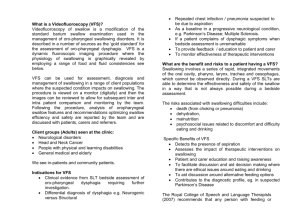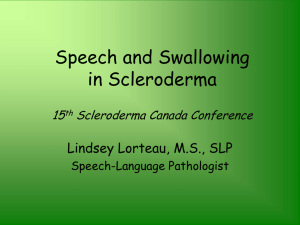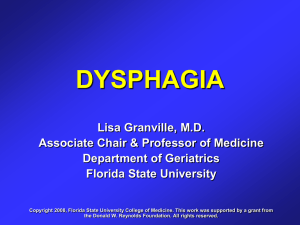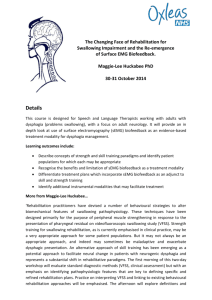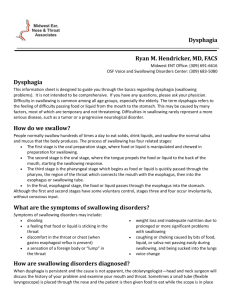Swallowing and Speech in Ataxia
advertisement
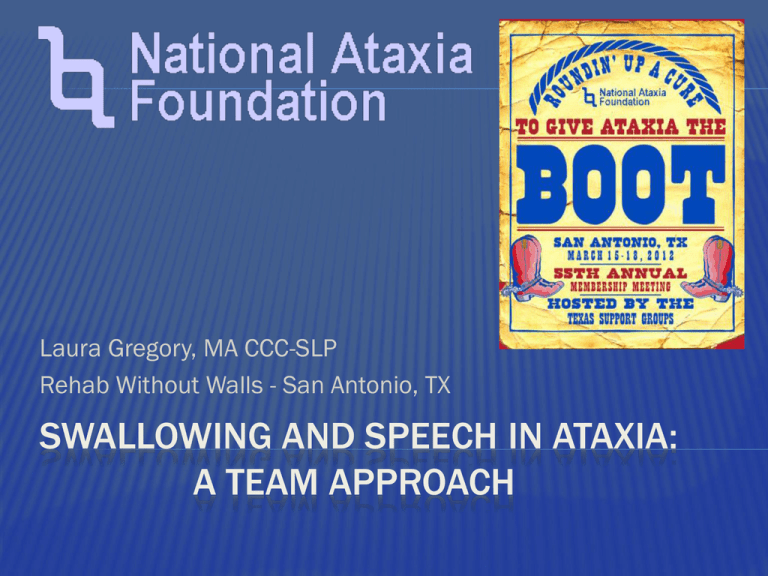
Laura Gregory, MA CCC-SLP Rehab Without Walls - San Antonio, TX SWALLOWING AND SPEECH IN ATAXIA: A TEAM APPROACH DISCLAIMER The information provided by speakers in any presentation made as part of the 2012 NAF Annual Membership Meeting is for informational use only. NAF encourages all attendees to consult with their primary care provider, neurologist, or other health care provider about any advice, exercise, therapies, medication, treatment, nutritional supplement, or regimen that may have been mentioned as part of any presentation. Products or services mentioned during these presentations does not imply endorsement by NAF. PRESENTER DISCLOSURES Laura Gregory, MA CCC-SLP The following personal financial relationships with commercial interests relevant to this presentation existed during the past 12 months: No relationships to disclose or list OUTLINE OF PRESENTATION Overview of the swallowing process Overview of speech The team approach Specific treatments and compensatory strategies SWALLOWING TERMINOLOGY Dysphagia – the clinical term for a disorder of swallowing Speech Language Pathologist (SLP) aka speech therapist – diagnoses and treats dysphagia Dysphagia is typically diagnosed through a videofluoroscopic or videoendoscopic swallow examination. VIDEO OF A NORMAL SWALLOW EFFECTS OF ATAXIA ON THE SWALLOW Decreased coordination and oral control Delayed swallow initiation Decreased pressure gradient to propel the bolus Impaired timing of reflexes for airway protection Pure cerebellar ataxia does not cause decreased strength or sensation WHAT ARE THE SIGNS AND SYMPTOMS? Coughing, especially with liquids and mixed or crumbly textures Penetration: food/liquid enters the airway but does not pass below the larynx Aspiration: food/liquid enters the airway and passes to the lungs – can lead to pneumonia Food feeling stuck in throat Liquids going into nasal cavity EFFECTS OF ATAXIA ON SPEECH Articulation of speech sounds is a complex process of movements of oral structures coordinated with respiration and voicing. Ataxia affects speech in the areas of Timing Coordination SPEECH DIFFICULTIES INCLUDE: Slurring of sounds “Scanning speech” with equal emphasis on each syllable Difficulty modulating volume of voice Difficulty controlling force or direction of oral movements (overshoot, undershoot) Inadequate or poorly coordinated breath support These are referred to as Ataxic Dysarthria RESULT Difficulty communicating with family and friends Fatigue SO WHAT CAN I DO? Educate yourself and others Be aware of early signs of difficulty with swallowing and speech Seek help before swallowing and speech difficulties become a major issue Recruit a support network IT TAKES A TEAM WHO ARE THE PLAYERS? YOU! Caregivers/family Friends Physicians Speech pathologist Occupational therapist Physical therapist Social worker/therapist Dietitian BECAUSE YOU ARE NOT JUST A MOUTH VS ROLES OF THE PLAYERS YOU! You know yourself best, so you are in the best position to make decisions regarding your healthcare in partnership with the team. The team approach won’t work without YOUR motivation and participation CAREGIVERS, FAMILY, AND FRIENDS Eating is a social activity! Communication goes two ways. PHYSICIAN Discusses signs and symptoms with you Makes appropriate referrals Communicates with the team along the way THERAPISTS Speech Pathologist Physical Therapist Evaluation and treatment of the oral/pharyngeal and respiratory components of swallowing Evaluation and treatment of postural and head control as they relate to speech and swallowing. Can also address respiration. Occupational Therapist Similar to physical therapist plus adaptive equipment OTHER POTENTIAL TEAM MEMBERS Social Worker/Therapist Emotional support for adjustment to disability. Assistance in finding compensatory strategies to decrease frustration when communicating with friends and family. Dietitian If changes to the diet are needed for swallowing safety, a dietitian can assist in maintaining adequate nutrition SWALLOWING: COMPENSATORY STRATEGIES Universal Sit upright at 90 degrees with good postural support Stay upright for 30 minutes after meals Take small bites and sips Reduce distractions, including talking Eat several small meals if fatigue is a factor Avoid problematic consistencies SWALLOWING: COMPENSATORY STRATEGIES An SLP may recommend other strategies based on individual needs. Chin tuck Swallowing maneuvers designed to protect the airway Diet modifications Soft or pureed food Solids chopped into smaller pieces Thickened liquids ADAPTIVE EQUIPMENT Provale cup: delivers 1 tsp per sip Bionix safe straw: 1 tsp ADAPTIVE EQUIPMENT Less measured but less expensive ways to control the flow of liquid : Squeeze the straw Use a cup with a lid ADAPTIVE EQUIPMENT Scooper bowl Weighted utensils Dycem SWALLOWING: POTENTIAL TREATMENTS Oral-motor exercises may be of some benefit to improve timing, coordination, and awareness. Neuro-muscular electrical stimulation (NMES), also referred to as Vitalstim, is not effective for ataxia alone but may be beneficial when there is accompanying weakness. ALTERNATE METHOD OF NUTRITION Naso-gastric tube- can be used for a short period of time when eating by mouth is not safe. Gastric tube or less commonly a jejunal tube can be surgically placed for long term supplemental or alternate nutrition. Choosing an alternate method of nutrition is a difficult decision that should involve the entire team and support network. SPEECH: COMPENSATORY STRATEGIES Speak face to face without distractions Educate unfamiliar listeners Break sentences into shorter phrases when you are not understood Introduce the topic using a single word Take your time SPEECH: POTENTIAL TREATMENTS Overarticulation Pacing/rhythmic training Speech agility exercises Lee Silverman Voice Therapy (LSVT) – Would be beneficial for Ataxia when a patient has difficulty speaking at a consistent volume or coordinating respiration with speech. Evidence base for multisystem atrophy. ADDITIONAL ACTIVITIES Yoga Music therapy AUGMENTATIVE/ALTERNATIVE COMMUNICATION Low tech: Alphabet board, picture board, etc. Voice output device (or ipad) Picture to speech Text to speech Access Hand Switch Switch/scanning Eye gaze AUGMENTATIVE/ALTERNATIVE COMMUNICATION Funding in Texas Specialized Telecommunications Assistance Program (STAP) http://stap.puc.state.tx.us Review of ipad apps http://www.spectronicsinoz.com/article/iphoneipa d-apps-for-aac GO TEAM!!!
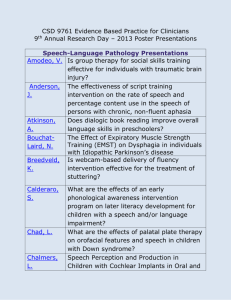
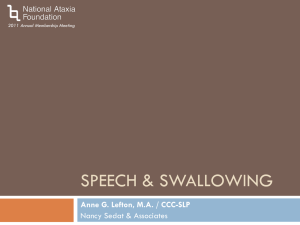
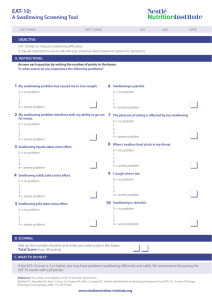
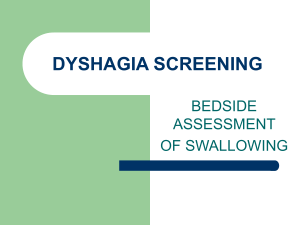
![Dysphagia Webinar, May, 2013[2]](http://s2.studylib.net/store/data/005382560_1-ff5244e89815170fde8b3f907df8b381-300x300.png)
